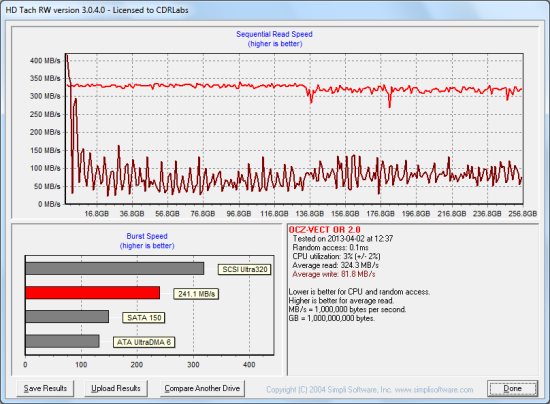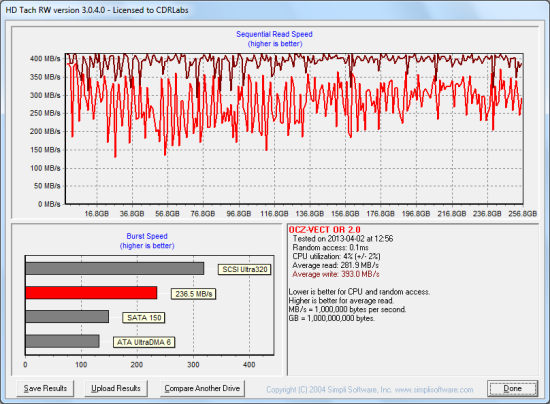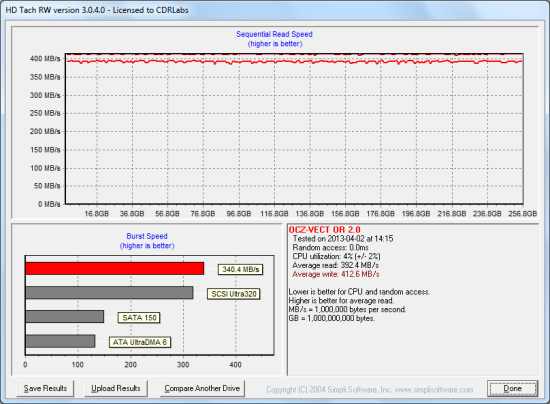TRIM Performance:
While SSD's offer many benefits, there are some downsides to using flash memory. One of the biggest issues people run into is performance degradation. Over time, an SSD will run out of fresh blocks and will have to write over data the file system has marked as deleted. This procedure is very complicated and can slow an SSD's write speeds considerably.
To fix this problem, most manufacturers have added TRIM support to their SSDs. The TRIM command allows an operating system, such as Windows 7, to tell an SSD which data blocks are no longer in use. Using this information, the drive pro-actively erases these blocks and adds them to the free block pool.

The Vector also uses a number of other flash management techniques including background garbage collection, dynamic and static wear-leveling and advanced flash defect management. Where flash defect management and wear leveling optimize the way data is written on the drive, garbage collection maintains "like new" performance by reorganizing data to maximize the number of free cells.
To test the Vector's TRIM and garbage collection functions, I first put the drive in a "dirty" state. I used Iometer to fill the entire drive and then ran a random write test for 30 minutes. Looking at the screenshot below, you can see that the Vector's average read and write speeds dropped to 324.3 MB/s and 81.8 MB/s, respectively.

OCZ Vector - Dirty
The Vector's average write speed bounced back up to 393 MB/s within a matter of minutes. However, its average read speed dropped down to 281.9 MB/s while it was recovering.

OCZ Vector - Recovering
I let the computer sit for about an hour and then reran the test. Looking at the screenshot below, you can see that the Vector's average read speed had increased to 368.3 MB/s.

OCZ Vector - After TRIM
Lastly, I used OCZ's Toolbox utility to perform a secure erase on the Vector. With the drive wiped clean, it had average read and write speeds of 392.4 MB/s and 412.6 MB/s, respectively.

OCZ Vector - Secure Erased
Final Thoughts:
OCZ has knocked another one out of the park with its new Vector Series SSD. Powered by the company's own Indilinx-infused Barefoot 3 controller, the Vector combines synchronous MLC NAND with a massive cache to deliver some of the best all around performance we've seen. In our sequential read and write tests, the 256GB Vector was able to read at speeds as high as 557 MB/s and write at speeds in excess of 490 MB/s. The drive also did very well in our random write tests, producing more than 78,000 IOPS at low queue depths. Moreover, it performed equally well with compressible and incompressible data and was able to sustain these speeds, even after intensive use.
Aside from the lack of hardware based encryption, the only real issue I have with the Vector is its price. Currently, prices on Amazon range from $140 up to $529, making the Vector more expensive than both the Plextor M5Pro Xtreme and Samsung SSD 840 Pro. Given, OCZ recently sweetened the pot by offering a free, downloadable copy of the game Far Cry 3, but the Vector's premium price tag is still a hard pill to swallow, especially if you're not a gamer.

Highs:
- Available in 128GB, 256GB and 512GB capacities
- Excellent sequential read and write speeds
- Good random read and write performance
- Performs equally well with compressible and incompressible data
- Good looking, ultra-slim design
- SATA 6Gb/s interface
- Synchronous NAND flash
- Large DRAM cache
- Supports TRIM and idle background garbage collection
- Includes a 2.5" to 3.5" adapter bracket
- Includes Acronis True Image cloning software
- 5 year warranty
Lows:
- Pricey
- Does not support hardware based encryption

